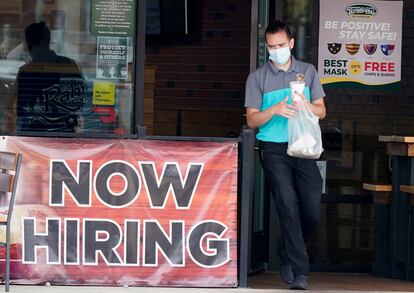US economic impact payments: Who will receive them, who much will they be for and when will they arrive?
The Treasury has already started the process of paying out the second round of coronavirus stimulus checks, while Congress continues to debate whether to raise the amount from $600 to $2,000

The second major coronavirus stimulus package was green-lit in the United States on Sunday night, after the draft legislation was signed by the president, Donald Trump, after weeks of tough negotiations between Republicans and Democrats. The aid package, which will cost $900 billion, includes a new round of economic impact payments that will end up in the pockets of Americans. The final value of those checks could change, given that this issue is the subject of a tug-of-war in Congress, but the Treasury has already begun the payment process. Here are the key points.
How much will the checks be for, $600 or $2,000? What has been approved and signed into law by Donald Trump are individual checks for $600, which the Treasury Department will start to deliver as soon as possible. Even so, Democrats and Republicans are engaged in a battle in Congress to try to raise the amount being paid out to $2,000, something that President Trump has also demanded. The House of Representatives, which has a Democratic majority, has given the green light to the proposal (with the support of 44 Republican members of Congress), but it is still pending approval by the Senate, which is controlled by the Republicans, who have until now rejected the increase. The measure would see the cost of the assistance rise by around $370 billion.
Who is eligible to receive these checks? Anyone with annual income of up to $75,000 (based on the 2019 tax year) will receive the full amount, currently set at $600, as well as the same amount for each child in that person’s care. That means a household made up of a couple and two children, for example, would receive $2,400. The amount will get smaller for those who earned more than $75,000 (by $5 for every extra $100) until disappearing above income of $99,000.
Even so, someone who is the head of a household and has an income of up to $112,000 will receive the $600 twice, and then the same amount again for each child in their care. This is also the case for couples who earn up to $150,000 combined (or for those whose partner has died during 2020). Anyone who earned above these limits in 2019 but is not doing so this year can claim the funds via their next tax return.
There is a significant development compared to the first economic impact payments: citizens who are married to people without a Social Security number will also be able to access them, something that favors citizens whose spouses are undocumented immigrants.
When will the money start to arrive? The Treasury Department, which is managing the payments, has already begun the process and, according to Secretary of the Treasury Steven Mnuchin, some payments were due to begin arriving on Tuesday night and will continue the coming week. Donald Trump’s delay in signing the draft legislation – he did not do so until Sunday night – and the continuing Christmas holiday celebrations could delay payment further.
They call them checks, but mostly they are deposits. In practice, the Treasury will pay out most of the economic impact payments via direct bank deposits. This will be the case for all US taxpayers who receive federal tax rebates from the IRS via this method. In the initial round of payments, these people were the first to receive their funds, whereas those who were sent checks had to wait longer for the money.
English version by Simon Hunter.
Tu suscripción se está usando en otro dispositivo
¿Quieres añadir otro usuario a tu suscripción?
Si continúas leyendo en este dispositivo, no se podrá leer en el otro.
FlechaTu suscripción se está usando en otro dispositivo y solo puedes acceder a EL PAÍS desde un dispositivo a la vez.
Si quieres compartir tu cuenta, cambia tu suscripción a la modalidad Premium, así podrás añadir otro usuario. Cada uno accederá con su propia cuenta de email, lo que os permitirá personalizar vuestra experiencia en EL PAÍS.
¿Tienes una suscripción de empresa? Accede aquí para contratar más cuentas.
En el caso de no saber quién está usando tu cuenta, te recomendamos cambiar tu contraseña aquí.
Si decides continuar compartiendo tu cuenta, este mensaje se mostrará en tu dispositivo y en el de la otra persona que está usando tu cuenta de forma indefinida, afectando a tu experiencia de lectura. Puedes consultar aquí los términos y condiciones de la suscripción digital.
More information
Archived In
Últimas noticias
Most viewed
- Reinhard Genzel, Nobel laureate in physics: ‘One-minute videos will never give you the truth’
- Oona Chaplin: ‘I told James Cameron that I was living in a treehouse and starting a permaculture project with a friend’
- Pablo Escobar’s hippos: A serious environmental problem, 40 years on
- Charles Dubouloz, mountaineering star, retires at 36 with a farewell tour inspired by Walter Bonatti
- Why we lost the habit of sleeping in two segments and how that changed our sense of time











































